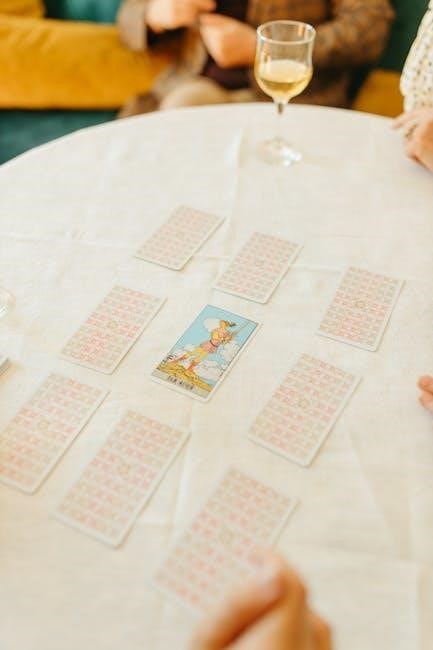
chameleon game cards pdf
Chameleon Game Cards PDF: An Overview
The Chameleon game is a social deduction game where identifying the Chameleon is key. A readily available resource for players is the Chameleon game cards PDF.

Understanding the Chameleon Game
The Chameleon game involves deception and deduction. Players receive secret information except for the Chameleon, who must blend in and deduce the secret word.
Core Concepts of the Game
At its core, the Chameleon game revolves around secret roles, hidden information, and social deduction. Each player, except for one, receives a card indicating a shared secret. The player without this knowledge is the Chameleon. The central concept is for the non-Chameleon players to identify the Chameleon without explicitly revealing the secret word or phrase.
The Chameleon, on the other hand, must cleverly deduce the secret information based on the clues provided by other players. This involves observing their behavior, analyzing their statements, and identifying patterns in their responses. The game hinges on bluffing, misdirection, and careful observation. Success depends on the ability to deceive or detect deception, making it a thrilling and engaging experience for all participants.
The dynamic between the informed players and the uninformed Chameleon creates a unique challenge. The non-Chameleons must provide enough information to expose the Chameleon, while simultaneously concealing the secret from them. The Chameleon must use their wit and cunning to blend in and avoid detection. This interplay of roles is what makes the game so captivating.
Game Components: Cards and More
The Chameleon game typically includes several key components that contribute to its unique gameplay. Central to the game are the Topic Cards, which feature a list of related words or concepts. These cards serve as the source of the secret word that players must subtly reference. Complementing these are Code Cards, displaying a grid with coordinates that correspond to the words on the Topic Card.
The Chameleon Card identifies the player who must remain hidden and deduce the secret word. Dice are used to determine the coordinates on the Code Card, adding an element of chance to the game. Players often use dry-erase markers and boards to write down clues, notes, and suspicions, enhancing the deductive aspect of the game.
Beyond these core components, some versions of the game may include additional elements such as role cards that offer variations in gameplay. The quality and design of these components contribute significantly to the overall experience. The cards are designed to be clear, concise, and easy to use, ensuring that players can focus on the strategic aspects of the game.

Rules and Gameplay
The Chameleon game revolves around deduction and deception. Players try to identify the Chameleon, who doesn’t know the secret word. Gameplay involves giving subtle clues and strategic voting to expose the imposter.
Basic Rules of the Chameleon Game
The Chameleon game’s basic rules are designed to facilitate a social deduction experience. Each player receives a card, with one player secretly designated as the Chameleon. The other players know the secret word, but the Chameleon does not.
The core mechanic involves players giving clues related to the secret word. However, the clues must be subtle enough not to reveal the word directly to the Chameleon. The Chameleon must blend in by providing a plausible clue without knowing the actual word.
After the clues are given, players discuss and attempt to identify the Chameleon. A vote is then held, and if the Chameleon is correctly identified, they have one chance to guess the secret word. If they guess correctly, the Chameleon wins; otherwise, the other players win. If the players fail to identify the Chameleon, the Chameleon also wins. The game encourages careful observation, strategic thinking, and social interaction.
The Chameleon’s Role and Objectives
As the Chameleon in the game, a player’s role is to blend seamlessly with the other players, all while remaining undetected. The primary objective is to deduce the secret word without any prior knowledge. This requires careful observation of the clues provided by the other players.
The Chameleon must craft a clue that seems relevant to the discussion, without actually knowing the secret word. This involves a degree of bluffing and creative thinking. A successful Chameleon will analyze the other players’ clues, identify common themes, and formulate a response that aligns with those themes.
Ultimately, the Chameleon wins if they either remain undetected throughout the round or, if caught, correctly guess the secret word. The challenge lies in maintaining a facade of knowledge while navigating the subtle hints and accusations of the other players. Strategic thinking and social manipulation are key skills for a successful Chameleon.
Non-Chameleon Players’ Role and Objectives
For players who are not the Chameleon, the primary objective is twofold: to identify the Chameleon and to provide subtle clues about the secret word. Each non-Chameleon player receives a code card indicating the secret word, and must then offer a one-word clue that relates to that word.
The challenge lies in giving a clue that is specific enough to be relevant, yet vague enough to avoid directly revealing the secret word to the Chameleon. Non-Chameleon players must also carefully observe the clues given by others, paying close attention to any inconsistencies or responses that seem out of place.
The non-Chameleon players win if they successfully identify the Chameleon. They lose if the Chameleon remains undetected or correctly guesses the secret word after being caught. Therefore, collaboration, careful analysis, and strategic clue-giving are essential for the non-Chameleon players to achieve their objectives and outsmart the Chameleon.

Game Variations and Modifications
The Chameleon game offers ample opportunities for variations and modifications. These can range from official rule tweaks to unofficial house rules, adding fresh layers of intrigue and replayability to the core gameplay experience.
Official and Unofficial Rule Variations
The Chameleon game, at its core, thrives on deception and deduction. However, its flexible nature allows for various rule alterations, both officially sanctioned and born from player creativity. Official variations might address player counts or specific card interactions, aiming to refine the game’s balance and strategic depth.
Unofficial rule variations, often referred to as “house rules,” provide a playground for players to experiment with new mechanics and challenges. These can include adjustments to scoring, modifications to the Chameleon’s abilities, or even the introduction of entirely new roles.
One popular variation involves giving the Chameleon two guesses at the secret word if caught, adding a layer of tension to their final moments. Another addresses larger player groups, ensuring that everyone remains engaged and the deduction process remains challenging. The beauty of these variations lies in their ability to tailor the game to suit different preferences and playstyles, ensuring a consistently fresh and engaging experience. Whether adhering to official guidelines or venturing into uncharted territory, these variations breathe new life into the Chameleon game, transforming it into a truly personalized experience.
House Rules and Customizations
Beyond the official rules and established variations, the Chameleon game truly shines when players introduce their own house rules and customizations. These personalized tweaks can significantly alter the gameplay experience, catering to specific group dynamics and preferences.
One common customization involves adjusting the difficulty level by modifying the word lists on the topic cards. Simpler words can make the game more accessible to younger players or newcomers, while more obscure terms can challenge experienced groups. Another popular approach is to introduce thematic variations, altering the word lists and clues to fit a specific theme, such as movies, books, or historical events.
Furthermore, players can experiment with different scoring systems, adjusting the points awarded for catching the Chameleon or correctly identifying the secret word. Some groups even introduce handicaps for more experienced players to level the playing field. Ultimately, the possibilities for house rules and customizations are endless, limited only by the players’ imagination. By embracing these personalized tweaks, players can transform the Chameleon game into a unique and endlessly replayable experience that perfectly suits their individual preferences.
Where to Find Chameleon Game Resources
Finding resources for the Chameleon game is easy, with online options available. Look for official game websites and PDF downloads for rules and cards to enhance your gaming experience.
Official Game Website and Downloads
The official game website serves as a central hub for all things related to the Chameleon game. Here, players can often find downloadable resources to enhance their gaming experience. These downloads frequently include printable versions of the Chameleon game cards.
The official website is the primary place where you might locate high-quality PDF versions of the game rules. Access to these resources ensures players have the correct and up-to-date guidelines for gameplay. It can also provide access to bonus content.
Many official websites also feature forums or communities where players can exchange tips, strategies, and house rules. The official website is the definitive source for authentic and reliable information.
Be cautious of unofficial sources. Ensure the files you download are from a verified source to protect against malware or incorrect game information.
PDF Rules and Instructions
A readily available resource for learning and playing the Chameleon game is the PDF rules and instructions document. This digital format allows players to easily access the game’s guidelines on various devices, ensuring everyone understands the core mechanics and objectives.
The PDF typically includes a comprehensive overview of the game’s components, including the Chameleon cards, code cards, and topic cards. It clearly outlines the setup process, detailing how to distribute cards and prepare for each round;
Furthermore, the instructions explain the roles of each player, focusing on the Chameleon’s objective to blend in and the other players’ mission to identify the imposter. The PDF also covers scoring, variations, and clarifications on specific rules.
Having a PDF version of the rules is convenient for quick reference. Players can consult the document during gameplay. This helps resolve disputes and ensures a fair and enjoyable experience.

Educational Aspects (for Colour Chameleon)
Colour Chameleon is a game designed for young children, focusing on color recognition skills. This game enhances cognitive development through interactive and engaging gameplay that makes learning fun.
Color Recognition Learning
Colour Chameleon is specifically designed to aid young children in developing their color recognition abilities. The game incorporates various colored components, such as spots and cards, that are integral to the gameplay. Children must identify and match colors correctly to progress, reinforcing their understanding of different hues.
The engaging nature of the game keeps children motivated, making the learning process enjoyable. By actively participating, children not only learn to distinguish between colors but also enhance their memory and cognitive skills. Colour Chameleon provides a hands-on approach to learning that is more effective than traditional methods.
Furthermore, the game encourages social interaction as children play together, fostering teamwork and communication skills. This holistic approach ensures that children develop a strong foundation in color recognition while also improving their social and emotional intelligence. The game is an excellent educational tool for early childhood development.
Game Components of Color Chameleon
Colour Chameleon includes several key components designed to enhance color recognition learning. The game features four Chameleon cards, each uniquely designed to appeal to young children. These cards serve as the player’s identity throughout the game, adding an element of fun and engagement.
In addition to the Chameleon cards, the game includes 24 colored spots. These spots come in four different colors: red, orange, yellow, and blue, with six spots per color. These spots are essential for gameplay, as players must collect and match them to their Chameleon cards.
The simplicity of the components ensures that young children can easily understand and interact with the game. The bright and vibrant colors of the cards and spots further aid in color recognition, making the learning process more effective and enjoyable. These components are durable and safe for children to handle.
The combination of Chameleon cards and colored spots creates a dynamic and interactive learning experience.